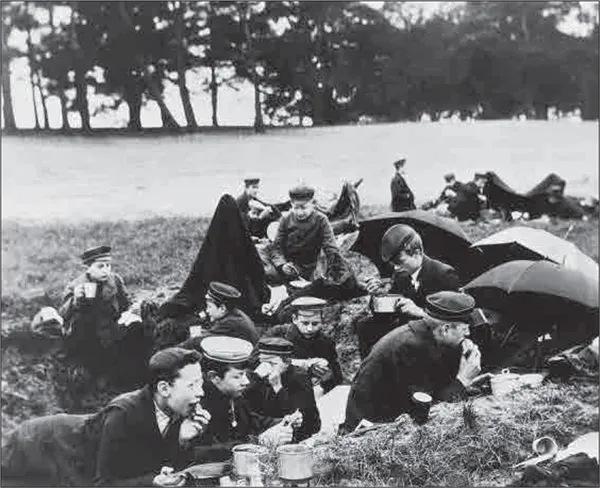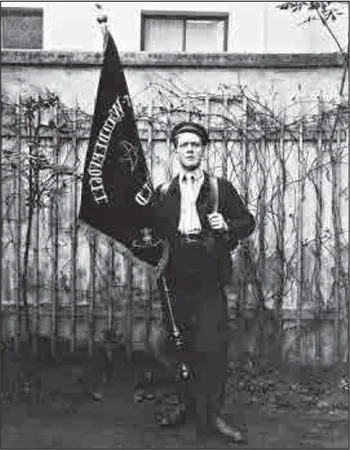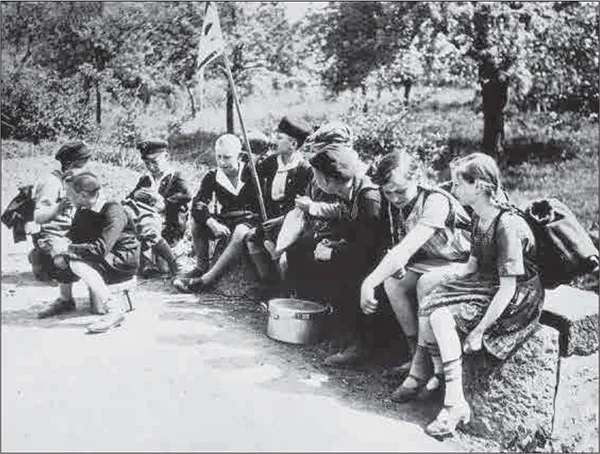
This is a test
- English
- ePUB (mobile friendly)
- Available on iOS & Android
eBook - ePub
Book details
Book preview
Table of contents
Citations
About This Book
Between 1933 and 1945, the majority of Germany's children were members of the Hitlerjugend – Hitler Youth – the junior branch of the Nazi Party. Exploring the development, organisation, education and indoctrination of the Hitler Youth, this book also looks at its combat role in World War II. Hitler Youth is an expertly-written, accessible account of the indoctrination of a generation of Germans.
Frequently asked questions
At the moment all of our mobile-responsive ePub books are available to download via the app. Most of our PDFs are also available to download and we're working on making the final remaining ones downloadable now. Learn more here.
Both plans give you full access to the library and all of Perlego’s features. The only differences are the price and subscription period: With the annual plan you’ll save around 30% compared to 12 months on the monthly plan.
We are an online textbook subscription service, where you can get access to an entire online library for less than the price of a single book per month. With over 1 million books across 1000+ topics, we’ve got you covered! Learn more here.
Look out for the read-aloud symbol on your next book to see if you can listen to it. The read-aloud tool reads text aloud for you, highlighting the text as it is being read. You can pause it, speed it up and slow it down. Learn more here.
Yes, you can access Hitler Youth by Brenda Ralph Lewis in PDF and/or ePUB format, as well as other popular books in History & World War II. We have over one million books available in our catalogue for you to explore.
Information
BEGINNINGS

Flag bearers of the Hitler Youth march past enthusiastic crowds to honour Admiral Adolf von Trotha at a commemoration of the anniversary of the Battle of Jutland in 1916.
On 19 March 1922, an invitation to German youth appeared in the Völkischer Beobachter, the newspaper of the National-sozialistische Deutsche Partei (NSDAP, also known as the Nazi Party):
‘We demand that the Nationalist Socialist Youth, and all other young Germans, irrespective of class or occupation, between 14 and 18 years of age, whose hearts are affected by the suffering and hardships afflicting the Fatherland, and who later desire to join the ranks of the fighters against the Jewish enemy, the sole originator of our present shame and suffering, enter the Youth League of the NSDAP …’
No subscription would be charged and all that was required of potential recruits was ‘love of one’s country and people, enjoyment of honest open combat and of healthy physical activity, the veneration of ethical and spiritual values, and the rejection of those values originating from Jewry …’
With the violent language that would soon become customary for their pronouncements, this statement set out the fundamentals that fuelled the Nazi purpose. Firstly, there was fury at the fate of defeated Germany, once a mighty military and imperial power, but now, after losing World War I, a remnant of her former self. Burdened with war guilt and reparations, her colonies confiscated and her armed forces dwindled to impotence, Germany had also suffered the loss of 13 per cent of her territory in Europe to new neighbouring countries such as Poland and Czechoslovakia. Secondly there was the atavistic hatred of the Jews who, the Nazis believed, had conspired with their other great enemy, the Communists, to engineer the ‘great betrayal’ which ended World War I: the Treaty of Versailles. It was this treaty, signed in 1919 by the Nazis’ third most hated body, the Weimar government of inter-war Germany, that Adolf Hitler had personally sworn to overturn.
Hitler’s rise
After the World War I, Hitler joined the propaganda unit of a volunteer corps made up of army veterans. His job was to spy on political meetings and bookmark the liberal, socialist and other left-wing organisations so detested by military and other right-wing groups. One organisation examined by Hitler in 1919 was the seemingly innocuous German Workers’ Party which came under suspicion because of the second word in its title. In investigating the German Workers’ Party, Hitler saw an excellent opportunity. Gradually he infiltrated the Party, took it over, renamed it Nationalsozialistische Deutsche Partei (NSDAP), and transformed it into an organisation with an extremely ambitious agenda. This was to restore Germany to its former greatness, turn her into a power which other nations would fear and respect, and punish the ‘November criminals’ whose signatures on the Versailles Treaty had brought the Fatherland so low.
German youth was to play a significant part in Hitler’s grand design. He envisaged them leading the Nazi spearhead into a glorious future brought about by the dawn of the ‘Aryan millennium’. Initially, the idea of youth participation came from Gustav Adolf Lenk, a young man who polished pianos for a living. After hearing Hitler speak at open-air meetings in Munich, Lenk became a keen devotee of National Socialism. At the end of 1921, he applied to join the Party, only to be told that, at 17, he was not old enough. Unabashed, Lenk enquired whether he could join the Party’s youth section. There was no youth section, but it was suggested that he create one.
At first, there was some opposition from within the Party. Nazis like Adolf Drexler, one of the founder members, believed that since the Party was itself so new, consolidation should take precedence over expansion. However, Hitler approved of Lenk’s idea and pulled rank on all of them. He talked Drexler round, sent a circular informing all Party members that a youth section was to be set up and followed it up with the invitation which appeared in the Völkischer Beobachter.
A problem immediately made itself apparent. Numerous, well-established rivals were already on the scene, which doubtless explained why the initial response to the Nazi Youth League was so paltry. On 13 May 1922, the Nazi Party hired a large Munich beer hall, the Bürgerbräu Keller, for a public meeting at which the official founding of the Youth League would be announced. A large number of people turned up and crowded into the beer hall to hear speeches by Hitler, the leader of the Sturmabteilung (the SA, or Nazi storm-troopers) Johann Ulrich Lintzch, and Gustav Lenk. However, there were only 17 youths among them.
The German Youth League
Lenk was nevertheless formally appointed Youth League leader and immediately began organising. Within a short time, he announced that the Youth League would consist of two sections which were forerunners of the later Jungvolk and Hitler Youth. The younger section, the Jungsturm Adolf Hitler, was for 14 to 16 year olds, and the senior section was for youths aged 16 to 18. Though still only 18, not especially charismatic and, compared to Hitler, no public speaker, Lenk was dynamic, innovative and endlessly energetic. He had to be, considering the formidable challenge presented by his rivals who had several years’ seniority among their credentials. In 1913, German youth movements were so far developed that 13 federations – including the Wandervögel (Birds of Passage) founded in 1896 and the Pathfinder Boy Scouts of 1908 – were represented at the celebrations for the twenty-fifth anniversary of Kaiser Wilhelm II’s accession to the throne. On 12 October 1913, a year before the outbreak of World War I, Free German Youth Day saw a parade of upright young men – every one abstainers from alcohol and cigarettes – who were devoted, like the putative Nazi Youth League, to healthy, outdoor, back-to-nature activities.
Strong competition
The Nazis were therefore offering little that was new, and did not aim to cater for other interests already well covered by more specialist organisations. For instance, the Evangelist youth movement which had originated in 1883, and the Catholic youth movement of 1909, took care of the youth’s spiritual side. The Germania federation was one of two concentrating on abstinence, while the workers’ socialist movement, founded in 1903 was, by its very nature, the political opposite of the hard-right Nazis.
Lenk nevertheless persisted and gradually, units of the Youth League were established in Nuremberg, Zeitz, Dresden, Hanau and Dortmund. Outside Germany, Lenk managed to plant the flag of the Youth League among the Sudeten Germans in Czechoslovakia and also in Austria, where he had contacts with the Nazi Party in Vienna. On 28 January 1923, the Jungsturm Adolf Hitler made its appearance at the first Nazi Parteitag (party day), a precursor to the later Nuremberg rallies.
There, the boys were solemnly presented with special pennants which featured the Nazi Party’s swastika symbol on a white background, an early instance of the dramatic pageantry which was to be so dominant in Nazi stagecraft.

Hitler’s failed putsch of 9 November 1923. This picture shows a lorry-load of uniformed ‘shock’ troops, including some youths, in a street in Munich.
All the same, despite the public show, the growth of new units and a promotion for Lenk as ‘national’ rather than ‘regional’ leader, the Youth League was still a relatively minor organisation. This became apparent in May 1923 when Lenk thought he was in a position to publish a special youth magazine, the Nationale Jungsturm. Subscribers proved to be too few and the magazine failed. Renamed the Nationalsozialistiche Jugend, it ended up as a supplement to the Völkischer Beobachter.

Pre-war Germany offered many opportunities for organised youth activities. The Wandervögel, founded in 1896, stressed the attractions of the countryside.
This was an embarrassing setback for Lenk. However, he had pushed back frontiers that still eluded the Nazi Party as a whole. In 1920 and 1921, attempts had been made to fuse the Party in Munich, its centre in Germany, with like-minded groups in Hanover, Czechoslovakia and Upper Silesia in Poland. These attempts had foundered because these groups refused to accept Hitler’s terms that they accept him as sole leader. The situation was no different two years later in 1923, but with 55,000 members, the Nazi Party had outpaced all the other organisations in Munich. The Bavarian capital was a political hotbed, seething with opposition to the Weimar government. Among the right-wing groups, the Nazis were therefore in pole position to take advantage of the hatred felt towards Weimar ministers and their acceptance of the Versailles Treaty. Unrest from both the political right and left had produced an atmosphere of chaos, barely kept under control by troops. The fragile balance of Germany was put in even greater doubt by the desperate financial crisis which occurred in June 1923 when the German Mark collapsed under the weight of reparations payments, and inflation began to run riot through the economy.
The French occupation of the Ruhr in January 1923 and their subsequent seizure of coal, timber and other materials as reparations in kind had provoked strikes, street demonstrations and sabotage, and so set a perfect scene for the Nazi Party’s first rally. On 27 January, flags, banners, pennants and the Aryan swastika emblem – since 1920 the symbol of the Nazi Party – plastered the streets of Munich as, to vociferous applause, Hitler raged against the Treaty of Versailles, and the Weimar government and all its works.
The Munich putsch
The reception he received seems to have persuaded him that the time had come for a putsch. This was intended to be Hitler’s bid for power which would begin with the kidnapping of Bavarian government leaders. On 9 November 1923, the fourth anniversary of the proclamation of the Weimar Republic, Hitler marched 3000 Nazis to the Bürgerbräu Keller and invaded a political meeting held by the Bavarian state commissioner, Gustav von Kahr. Hitler leapt onto a chair, brandishing a pistol. He fired a shot into the ceiling and proclaimed: ‘The National Revolution has begun!’
But there was no revolution. The Bavarian police intervened and Hitler was forced to escape to avoid arrest. The authorities caught up with him two days later, and on 1 April 1924, after a five-week trial, Hitler and other leading Nazis were sentenced to imprisonment. Hitler received a five year sentence, though he was released on parole after only eight months. Both the Nazi Party and the Youth League were disbanded and outlawed on Weimar government orders.

Dressed somewhat self-consciously in his rural outfit, cap at a jaunty, casual angle, this member of the Wandervögel poses for the camera with the organisation’s banner.
However, those who believed that this was the end of Adolf Hitler had not been listening properly at his trial. He had used the dock like a podium, boldly peddling his Nazi message and asserting that Germany and the whole world would one day come round to his way of thinking. His performance made him better known in Germany than he had been before the attempted putsch, for which he was proud to claim sole credit.
Lenk’s continued efforts
Meanwhile, Gustav Lenk twice attempted to re-found a youth movement under innocent-sounding names: the Patriotic Youth Association of Greater Germany or the Greater German Youth Movement. The Bavarian authorities guessed that these were simply covers for the Nazi Youth League, and Lenk joined Adolf Hitler and the other Nazi leaders in Landsberg fortress. Hitler was released on 1 December 1924, and Lenk at about the same time.

Boys and girls – and their marching drums – take a rest while hiking in the countryside. The two girls closest to the camera are not ideally shod.
Although Hitler had entered Landsberg as a failed fanatic, just another extremist with strange political ideas, he came out in much more dangerous guise: as a man who realised why his putsch had gone wrong, and how he could get it right next time. State Prosecutor Stenglein had more or less told him how in his closing speech at the trial. ‘It is understandable that the enthusiastic youth suffers from impatience’, Stenglein told the court, ‘but youth must be disciplined and led in the right direction by mature men. Impatience must be replaced by the ability to work quietly and confidently for the future, waiting with clenched teeth until the hour is ripe.’
With this blueprint for the future in mind, Hitler had come to realise that power should not be seized by the throat, but won at the polls: the Nazi Party would in future participate in the democratic process and then pervert it to its own purposes.
Mein Kampf
Hitler had set out those purposes while in Landsberg fortress. There, with the assistance of his devoted henchman Rudolf Hess, he wrote his semi-autobiography, Mein Kampf (My Struggle) a turgid, often misspelt, agglomeration of crude prejudice, conspiracy theory, race hatred and perv...
Table of contents
- Cover
- Title page
- Copyright page
- Contents
- Introduction
- 1. Beginnings
- 2. Organising the Youth
- 3. Life in the Hitler Youth
- 4. Education in Nazi Germany
- 5. Renegades and Resistance
- 6. Preparing for War
- 7. War Declared
- 8. Into Battle
- 9. Escape from France
- 10. The End of the Hitler Youth
- Epilogue
- Appendices
- Index